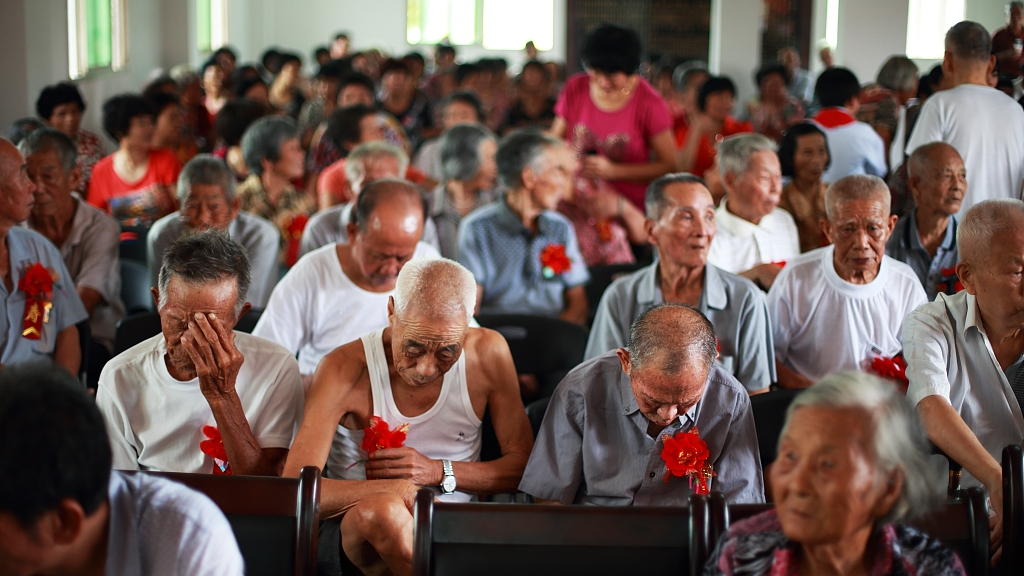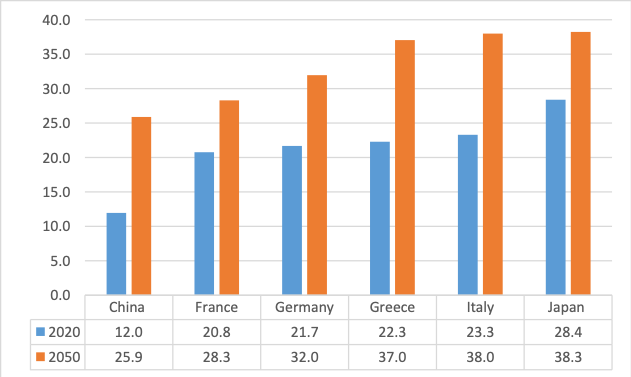
Editor's Note: Michele Bruni is the team leader of the EU-China Social Protection Reform Project, a four-year cooperation initiative aimed at promoting social equity and inclusiveness of economic development throughout Chinese society funded by the European Commission and the Government of China. He is currently serving as the team leader of a labor market project at the Asian Development Bank. The article reflects the author's opinions, and not necessarily the views of CGTN.
It is a Chinese tradition to pay tribute and respect to elders and ancestors on the Double Ninth Festival. As people celebrate this tradition on October 7, China is going through an aging problem.
In the next decades, the aging process in China will be particularly impressive. The number of elderlies will increase from 172 million to 366 million by 2050. The number of people in working age, the source of labor supply, will decline from 1,012 million to 848 million while the population of the young will decline from 255 million to 201 million.
In fact, by comparison, China is still quite a young society. According to the estimates of the United Nations Department of Economic and Social Affairs, the percentage of Chinese aged 65 or above is expected to reach 12 percent in 2020, a value that compares very favorably with major European countries and Japan. However, it is generally acknowledged that China is going to age faster than in other countries. Considering a zero-migration scenario, by 2050 the percentage of Chinese aged 65 or above is projected to reach 25.9 percent. The growth rate is faster than in other major aging societies.

Percentage of elderly people in selected countries, in 2020 and 2050, based on United Nations Department of Economic and Social Affairs. / Created by Michele Bruni.
Percentage of elderly people in selected countries, in 2020 and 2050, based on United Nations Department of Economic and Social Affairs. / Created by Michele Bruni.
The aging process of Chinese society will therefore be very fast. Despite being less pronounced than that will affect Japan, Italy, Germany and other developed countries, it will be pronounced enough to require immediate policy measures aimed to face a double problem: an increasing number of elderlies to care for and a decreasing number of people that can produce goods and services and care for the elderly.
The first step to be taken is to progressively restructure the phases of life in such a way as to maximize the potential labor supply by allowing a large number of cohorts to be co-present in the labor market, while diminishing the number of elderly and allowing the young a longer period of education and training. More specifically, it should be considered to increase the legal retirement age to at least 70 by 2050, allowing young people to study until the age of 25 and still work a number of years sufficient to build a decent pension. This would also improve the ratio between retired and employed. These new phases of life would be coherent with the increased duration of life and respond to the new technological environment.

Allowing young people to study until the age of 25 would provide them with the training and skills they need for the fast-developing new world. /VCG Photo
Allowing young people to study until the age of 25 would provide them with the training and skills they need for the fast-developing new world. /VCG Photo
The 5G revolution and the robotization process are already well underway. They will be called to contribute to increasing total productivity in order to sustain economic growth in the presence of declining labor supply. This will, however, require a labor force endowed not only with more and better vocational training, but especially more education. A good cultural background is necessary to make the young receptive to complex technological training, while making the citizens of tomorrow aware of the increasing socioeconomic risk of advanced technologies.
New and better technologies are also expected to contribute in many ways to elderly care. The elderly of tomorrow are the young of today and they will be ready for more technological care.
However, even bringing the legal retirement age to 70 by 2050 the potential labor supply still will decline by 16 percent. At the same time, while in 1950, for every person 70 years old or above, there were 17 people between 30 and 60. Right now this figure stands at eight. By 2050, this number will further drop to just two. Raising retirement age and technological change might be just not enough to deal with the potential problem of labor shortage that could affect China in the next 30 years. We'll need to wait and see if these actions will be sufficient in facing both the labor shortage and sustain economic growth in line with the expectations of the Chinese people.
(If you want to contribute and have specific expertise, please contact us at opinions@cgtn.com.)